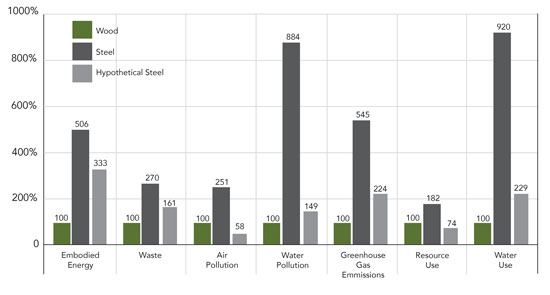Building Materials Matter
Carbon Footprint: Reducing Greenhouse Gases
Although there is growing awareness that using wood from sustainably managed forests can reduce a building’s carbon footprint, only a portion of wood’s benefits are recognized in an LCA. As noted, the LCA literature review concluded that fossil fuel consumption and potential contributions to the greenhouse effect tend to be minor for wood products compared with competing products. This is because wood products require less energy to manufacture than other major building materials, and most of that comes from renewable biomass (e.g., sawdust, bark and other residual fiber).3
The other aspect to wood’s carbon footprint is that as trees grow they absorb carbon dioxide (CO2) from the atmosphere, release the oxygen (O2), and incorporate the carbon into their wood, leaves or needles, roots, and surrounding soil. Young, vigorously growing trees take up carbon quickly, with the rate slowing as they reach maturity (typically 60-100 years, depending on species and environmental factors). Over time, one of three things then happens:
- When the trees get older, they start to decay and slowly release the stored carbon.
- The forest succumbs to wildfire, insects or disease and releases the carbon quickly.
- The trees are harvested and manufactured into products, which continue to store much of the carbon. (Wood material is approximately 50 percent carbon by dry weight.) In the case of wood buildings, the carbon is kept out of the atmosphere for the lifetime of the structure—or longer if the wood is reclaimed at the end of the building’s service life and reused or manufactured into other products.
Unless the land is converted to another use, the cycle begins again as the forest regenerates and young seedlings once again begin absorbing CO2. For more information, the USDA Forest Service recently released an infographic illustrating the forest/carbon cycle (www.fs.fed.us/climatechange/advisor/scorecard/Carbon_Infographic_Final.pdf).
Initial Embodied Impacts: From Extraction to Construction
The impact of materials from extraction or harvesting through manufacturing, transportation and construction are considered initial embodied impacts. They are distinct from operational impacts, which result from a building’s operation and from recurring embodied impacts, which relate to the durability of building materials, components and systems; how well they’re maintained; and the service life of the building. Building materials tend to have the greatest impact from extraction through manufacturing. Within an LCA, this is also where wood’s advantages are most evident.

Wood products store carbon. In the case of wood buildings, the carbon is kept out of the atmosphere for the lifetime of the structure—or longer if the wood is reclaimed and reused or manufactured into other products.
Raw Materials
The life cycle of building products typically starts with the extraction of raw resources such as timber, iron ore, limestone and aggregates. The collection of data starts here, with the tracking of energy use and emissions to air, water and land per unit of resource. Wood’s impacts during this phase are relatively low compared with concrete and steel, which are made from substances that must be mined and heated to extremely high temperatures.5
A typical concrete mix is about 10 to 15 percent cement, 60 to 75 percent aggregate and 15 to 20 percent water, though proportions change to achieve different requirements for strength and flexibility. While most of concrete’s ingredients are themselves manufactured products or mined materials, it’s the cement in concrete that has the highest embodied energy.6 According to the U.S. Energy Information Administration, the cement industry is the most energy-intensive of all manufacturing industries. Cement is also unique in its heavy reliance on coal and petroleum coke.7
A major ingredient needed for cement is limestone, which is found in abundance in many places in the world. In most cases, limestone is blasted from surface mines and removed in large blocks to a crusher, mixed with other raw materials, and transferred to a rotating furnace, where it is heated to about 2,700 degrees Fahrenheit in order for the materials to coalesce. The mixture is cooled and ground to fine powder (cement), which is transported to its destination by truck, rail or ship. Fly ash, a byproduct of coal burning, can be substituted for some of the cement, as can a variety of other ingredients, with associated reductions in carbon footprint.8,9,10,11
Steel is an alloy consisting mainly of iron and has a carbon content between 0.2 percent and 2.1 percent by weight, depending on grade. Steel’s main ingredient is iron ore, which must be extracted through open-pit mining and heated to extremely high temperatures. In surface mines, ground is removed from large areas to expose the ore. Ore is then crushed, sorted and transported by train or ship to the blast furnace, where the iron is heated to 3,000 degrees Fahrenheit, usually with charcoal or coke, and charged with the ore and limestone. The molten iron drains off, and iron ingots are formed. This pig iron, as the ingots are called, is the basis for steel.12, 13, 14, 15, 16, 17
For both concrete and steel there are environmental consequences from open-pit mining, and from the fossil fuels used to process the raw materials. However, both industries continue making strides to lighten their environmental footprint.18, 19, 20











